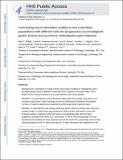Contrasting serum biomarker profiles in two Colombian populations with different risks for progression of premalignant gastric lesions during chronic Helicobacter pylori infection
Author(s)
Whary, Mark T; Avenia, Jose M Restrepo; Bravo, Luis E; Lofgren, Jennifer L; Lertpiriyapong, Kvin; Mera-Giler, Robertino; Piazuelo, M Blanca; Correa, Pelayo; Peek, Richard M; Wilson, Keith T; Fox, James G; ... Show more Show less
DownloadAccepted version (1.735Mb)
Publisher with Creative Commons License
Publisher with Creative Commons License
Creative Commons Attribution
Terms of use
Metadata
Show full item recordAbstract
© 2020 Background: Colombians in coastal Tumaco have a lower incidence of Helicobacter pylori-associated gastric cancer compared to individuals from Tuquerres in the high Andes. This is despite nearly universal prevalence of H. pylori infection and chronic gastritis. Methods: H. pylori infection was confirmed by Steiner stain and serology using African and European-origin strains. Gastric histology and serum inflammatory biomarkers in dyspeptic Tumaco or Tuquerres patients were evaluated to predict progression of gastric lesions. Results: H. pylori infection was nearly universal by Steiner stain and serology. IgG response to European-origin H. pylori strains were greater than African-origin. High gastric cancer-risk Tuquerres patients, compared to low-risk Tumaco, had significant odds ratios for lesion progression associated with serum IL-5, trefoil factor 3 (TFF3), and low pepsinogen I/II ratio. Sensitivity and specificity for these parameters was 63.8% and 67.9%, respectively, with correctly classifying patients at 66.7%. Most odds ratios for 26 other biomarkers were significant for the town of residency, indicating an environmental impact on Tumaco patients associated with decreased lesion progression. Conclusion: An IL-5 association with progression of gastric lesions is novel and could be evaluated in addition to TFF3 and pepsinogen I/II ratio as a non-invasive prognostic screen. Results suggest Tumaco patients were exposed to infectious diseases beyond H. pylori such as the documented high incidence of helminthiasis and toxoplasmosis. Impact: Results support a prior recommendation to evaluate TFF3 and pepsinogen I/II together to predict aggressive gastric histology. Our data indicate IL-5 should be further evaluated as prognostic parameter.
Date issued
2020-05Department
Massachusetts Institute of Technology. Division of Comparative Medicine; Massachusetts Institute of Technology. Department of Biological EngineeringJournal
Cancer Epidemiology
Publisher
Elsevier BV
ISSN
1877-7821